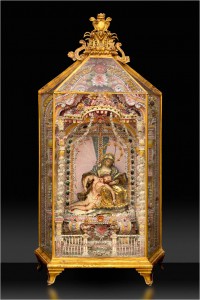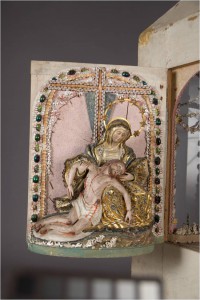
Dr. Mitchell Merling, Paul Mellon Curator and Head of the Department of European Art
Dr. Mitchell Merling, VMFA’s Paul Mellon Curator and Head of the Department of European Art, remarked that “European history did not just happen in Europe,” when explaining the acquisition of Our Lady of Piety. As European nations spread their political influence throughout the world during the colonial period, they brought their art, culture, and religion to the “New World.” Our Lady of Piety is a Brazilian-made sculpture that shows the influence of Baroque and Rococo styles. It was created in the second half of the 18th century and influenced by larger art movements in Europe. It tells the story of colonialism, its partner Catholicism, and the political, social, religious, and artistic culture of Brazil at the time.
Click Here to view the full transcript of the interview with Dr. Mitchell Merling, Paul Mellon Curator and Head of the Department of European Art!

Our Lady of Piety
Brazilian Oratory
VMFA Photo Resources
Brazil was originally colonized by Portugal in 1500. Our Lady of Piety, as an oratory, would have been made for the home of a wealthy Brazilian to be used as a devotional piece. This meant that the practice of faith was no longer confined to a church. The Catholic Counter-Reformation sought to make the faith more important and visible in the lives of its followers and this included the creation of the Jesuit order to send out missionaries, the creation of church-funded schools, and a renewed emphasis on private devotion, often through oratories such as Our Lady of Piety. These oratories ranged in size from small pieces worn around the necks of shepherds and traveling priests to elaborate shrines that served as a focal point in wealthy homes.

Our Lady of Piety
Brazilian Oratory
Pieta figures before conservation
VMFA Photo Resources
The role of religion in the colonization process was a by-product of the Protestant Reformation and subsequent Catholic Counter-Reformation. Many Christian missionaries crossed the ocean to the “New World” because they felt driven by God to “save the souls” of the natives. This evangelical drive was considered an urgent and strictly spiritual mission, without political influence. The Counter-Reformation-era Catholic Church was still recovering from the formation of Protestantism and seeking to recoup its influence around the world. This affected the way that its leaders chose to interact with native Brazilians, often depicting Christ as he is [depicted] in Our Lady of Piety, gory and tortured. This would become the traditional image for South American images of Christ because the Europeans found that the story of Jesus and his suffering inspired people to convert.
Dr. Merling remarked of the piece, “it shows the whole colonial impulse to capture the spirit of the place and take it over and turn it into something European.” Despite the dominance of the European artistic styles and religion, the unique character of Brazil is not suppressed. The Europeans brought their religion and its tenets, but their beauty is magnified by the distinctively Brazilian voice given by the shells, coral, beetles, palm capitals, and storks. These elements, which are both from and reflect the Brazilian landscape, place the European narrative in the context of the lives of the South Americans who used Our Lady of Piety in worship.
Links to Other Pages
Brazilian Oratory: Baroque, Rococo, and Local Influences
Brazilian Oratory: Notes on Brazilian History
Our Lady of Piety Oratory: The Influence of European Religion on South America
Our Lady of Piety Oratory: Condition through the Years
Our Lady of Piety Oratory: Conservation
The Story of How the Beetle got its Colors